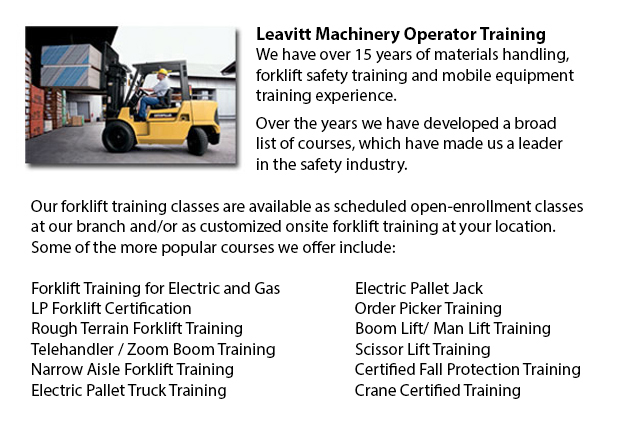
Rough Terrain Forklifts Training Markham - There are essentially two kinds of lift trucks within the manufacturing business, the rough terrain model and the industrial version. Rough terrain lift trucks appeared in the 1940's intended predominantly for use on irregular roads, ideal for lumberyards and construction sites, providing lifting muscle when there was no paved surface available.
Rough ground forklifts normally employ an internal combustion engine with a battery for power. The engines can operate on propane, diesel or gas. Many suppliers are playing with rough terrain lift trucks that consume vegetable matter and run from ethanol. Large pneumatic tires with deep treads distinguish these forklifts to permit them to grab onto the roughest ground type without any misstep or drifting.
The earliest styles of rough terrain lift trucks were able to carry weights of up to 1000 lbs, with forks that could run underneath the item, lift it a tiny bit and then move it to an alternate location. After some time on the market, rough terrain lift trucks had been given additional shipping strength to about 2000 lbs capacity. Telescoping booms were added in the 1960's, enabling them to stack materials a great deal higher than in preceding years. The telescoping model characteristic is a staple of nearly all all terrain forklifts nowadays. Present styles are capable of managing well over 4000 lbs thanks to the continual enhancements over time. Telescoping capability has also improved with some styles attaining a height of 35 feet. Operator safety has also become a focus with some all terrain lift trucks now developed are outfitted with an enclosed cab for the operator, as opposed to the older open air seating capacity.
The rough terrain lift trucks on the market nowadays both run well on unpaved roads and paved floors. This kind of rough terrain forklift is marketed for its' flexibility enabling the possibility for businesses to use one unit to carry materials from an outside working area into a warehouse.
-
Pneumatic Forklifts
Pneumatic Forklifts Training Markham - Widely utilized in shipping plants, the pneumatic forklift or pallet vehicle, can be used to transfer resources that are positioned onto pallets. A pneumatic lift truck commonly has a pair of steel blades instal... More -
JLG Telehandler
JLG Telehandler Training Markham - In the late 1960's John L. Grove, with his wife Cora embarked on on a cross country trip in their RV. Freshly retired, after spending several years working with his brother to develop their crane business into an ma... More -
Aerial Lifts
Aerial Lift Training Markham - Aerial jacks are able to accommodate numerous duties involving high and hard reaching spaces. Normally used to carry out routine preservation in buildings with tall ceilings, prune tree branches, hoist heavy shelving un... More -
Hyster Forklift
Hyster Forklift Training Markham - As a world leader in forklift trucks, Hyster continually strives for excellence in product quality and safety. However, it began as a manufacturer of lifting machines as well as winches. Most of its production was... More -
Scissor Pallet Trucks
Scissor Pallet Truck Training Markham - Scissor lift pallet vehicles are created to have the ability to move and stack pallets with a built-in lifting apparatus that permits the pallets to be elevated. This apparatus is incredibly functional for work... More

Forklift Certification Markham
TOLL FREE: 1-888-254-6157
Markham, Ontario
forkliftcertificationmarkham.com
Email Us
About Us


